This article needs additional citations for verification .(December 2009) |
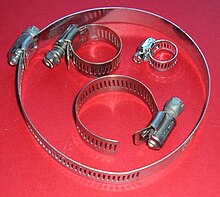
A hose clamp (hose clip,hose lock or Jubilee Clip (UK)) is a device used to attach and seal a hose onto a fitting such as a barb or nipple.
This article needs additional citations for verification .(December 2009) |

A hose clamp (hose clip,hose lock or Jubilee Clip (UK)) is a device used to attach and seal a hose onto a fitting such as a barb or nipple.
Many types are available, including :
Screw clamps consist of a band, often galvanized or stainless steel, into which a screw thread pattern has been cut or pressed. One end of the band contains a captive screw. The clamp is put around the hose or tube to be connected, with the loose end being fed into a narrow space between the band and the captive screw. When the screw is turned, it acts as a worm drive pulling the threads of the band, causing the band to tighten around the hose (or when screwed the opposite direction, to loosen). Screw clamps are normally used for hoses 1/2 inch diameter and up, with other clamps used for smaller hoses.
The first patent for a worm-drive hose clamp was granted to Swedish inventor Knut Edwin Bergström in 1896 [1] Bergström founded “Allmänna Brandredskapsaffären E. Bergström & Co.” in 1896 (ABA) to manufacture these worm gear clamps.
Other names for the worm gear hose clamp include worm drive clamp, worm gear clips, clamps, band clamps, hose clips, and genericized names such as Jubilee Clip.
Many public organizations maintain hose clamp standards, such as Aerospace Industries Association's National Aerospace Standards NAS1922 and NAS1924, the Society of Automotive Engineers' J1508, etc. [2] [3]
Pairs of screw clamps on a short rubber tube form a "no-hub band," often used for attaching sections of domestic wastewater piping, or used for other pipes as a flexible coupler (to fix alignment difficulties or to prevent pipe breakage due to relative movement of sections) or an emergency repair.

They can also be used in a similar way, as a simple means for the transmission of small amounts of power. A short length of hose is clipped between two shafts where vibration or variations in alignment may be taken up by the flexibility of the hose. This technique is well adapted to use for mock-ups in a development laboratory.
This type of clamp was marketed in 1921 by ex Royal Navy Commander, Lumley Robinson, who founded L. Robinson & Co (Gillingham) Ltd., a business in Gillingham, Kent. The company owns the trademark for Jubilee Clip.
Similar types of clamps for hoses include the Marman clamp, which also has a screw band and a solid screw.
Interlocking plastic clamps, where the large Fin Clip Base is designed for overlocking and interlocking the jaw to the required tightness.
T clamps are designed for high pressure pipes and hoses such as turbo pressure hoses and coolant hoses for high pressure engines. These clamps have a small grub screw that pulls the two halves of the clamp together to securely fasten heavy duty hoses.

Spring clamps are typically made from a strip of spring steel, cut so that one side has a narrow protrusion centered on the end, and the other side a pair of narrow protrusions on either side. The ends of these protrusions are then bent outwards, and the strip rolled to form a ring, with the protruding tabs intermeshing. To use the clamp, the exposed tabs are pressed towards each other (typically using pliers), increasing the diameter of the ring, and the clamp is slid onto the hose, past the portion that will go onto the barb. The hose is then fit onto the barb, the clamp expanded again, slid onto the portion of the hose over the barb, then released, compressing the hose onto the barb. Clamps of this design are rarely used for high pressures or large hoses, as they would require unwieldy amounts of steel to generate enough clamping force, and be impossible to work with using just hand tools. They are commonly used on automotive cooling system hoses several inches in diameter, for example on most water-cooled Volkswagen automobiles.
Spring clamps are particularly suited for confined or otherwise awkward places where other clip types would require tightening tools applied from narrow and possibly inaccessible angles. This has made them particularly popular for applications such as automotive engine bays and for securing barb connections in PC water-cooling.

Another type of spring clamp, typically only used on vacuum hoses, is just a piece of spring steel wire bent into a loop, with the ends curled to provide handles. These are used similar to standard spring clamps, but are just pinched by hand, and provide very little clamping force. Rather than attempting to seal a hose into a barb, they just place a slight pressure on the hose, helping to keep it from sliding off the barb.

Wire clamps consist of a piece of heavy wire, typically made of steel, first bent into a tight U, then formed into a ring shape with one end overlapping the other, and finally the ends bent outwards and cut. A captive nut is attached to one end, and a captive screw is attached to the other end. When the screw is tightened, the overlapped ends of the wire are pushed apart, tightening the wire loop around the hose. For an explanation of why this design is used, see the section on sealing the connection.
Ear clamps consist of a band (usually stainless steel) into which one or more “ears” or closing elements have been formed. The clamp is placed over the end of the hose or tube to be connected and when each ear is closed at the base of the ear with a special pincer tool, it permanently deforms, pulling the band, and causing the band to tighten around the hose. The size of clamp should be chosen such that the ear(s) are almost completely closed on installation.
Other features of this style of clamp include: narrow band widths, intended to provide a concentrated compression of the hose or tube; and tamper resistance, due to the permanent deformation of the clamp’s “ear”. If closure of the clamp “ear(s)” is performed to manufacturer's recommendations, which generally provide for constant jaw force, the sealing effect is not unduly sensitive to component tolerance variations.
Some such clamps feature dimples intended to provide a spring effect when the diameter of the hose or tube contracts or expands due to thermal or mechanical effects.
A stepless type of ear clamp was invented by Hans Oetiker in Horgen, Switzerland, which eliminates steps or gaps on the inner circumference of the clamp. This is said to provide uniform compression and a 360° seal. Such stepless clamps are claimed to be well suited to applications involving thin-walled hoses, supposedly with higher retained loads. This suggests they should be considered for difficult to seal applications such as molded plastics or other less malleable materials, commonly used in the automotive industry.
Many other methods can be used to attach hoses or tubing, such as compression fittings (where a nylon or soft metal ferrule is compressed onto the hose by the tightening of the fitting), push-fit fittings (where the hose is inserted inside of a compression sleeve, designed such that force against the hose causes the sleeve to tighten), swage fittings (where a stiff collar is compressed onto the hose), clamp fittings (where two blocks are tightened onto the sides of the hose, often found on garden hoses), crimp banding (similar to worm gear banding but a crimp is used instead of a screw/thread), and a multitude of others. However, these devices are not typically referred to as hose clamps.
Hose clamps are typically limited to moderate pressures, such as those found in automotive and home applications. At high pressures, especially with large hose sizes, the clamp would have to be unwieldy to be able to withstand the forces expanding it without allowing the hose to slide off the barb or a leak to form. For these high pressure applications, compression fittings, thick crimp fittings, or other designs are normally used.
Hose clamps are frequently used for things other than their intended use, and are often used as a more permanent version of duct tape wherever a tightening band around something would be useful. The screw band type in particular is very strong, and is used for non-plumbing purposes far more than the other types. These clamps can be found doing everything from mounting signs to holding together emergency (or otherwise) home repairs.
Another handy attribute: worm-drive hose clamps can be daisy-chained or "siamesed" to make a long clamp, if you have several, shorter than the job requires.
Some things seen assembled with hose clamps include the tail boom on a GMP Cricket model helicopter, a homemade gas scooter, makeshift pipe hangers, mounts for rooftop TV and shortwave antennas, and virtually every imaginable automobile body component.
Hose clamps are commonly used in the agriculture industry as well. They are used on Anhydrous Ammonia hoses and are made from a combination of steel and iron. Anhydrous ammonia hose clamps are often cadmium plated to prevent rust and corrosion. [4]
One of the fundamental goals of most hose clamps is to ensure a tight seal between the hose and the barb, preventing the working fluid from escaping. To this goal, they are designed to provide even pressure on all sides, with no gaps. An example of this would be wire clamps. An obvious design would seem to be simply having a wire around the hose, one end attached to a nut, and the other end to the screw, and when tightened, pulling the ends of the wire towards each other. However, this will leave a gap where no pressure is applied (underneath the screw), and cause a leak. To combat this, the more complicated and weaker design of having the ends overlap and then be pushed apart from each other is used, as this ensures pressure around the entire circumference of the hose.
To ensure a good seal, the barb, hose nipple, or beaded tube must be smooth and free of nicks, scratches, or contamination. Stuck hoses should never be removed by slitting them, as this can leave a scratch on the fitting which will cause a leak.
The other goal of a hose clamp is to provide mechanical attachment keeping the hose attached to a barb, hose nipple, or tube. To do this the clamp is typically placed on the hose behind the first ramp of the barb or behind the raised area near the end of and completely around the circumference of the hose nipple or tube called a bead. If the hose were to slide the clamp would have to expand to fit over the barb or raised bead. This keeps the hose attached to the barb, hose nipple, or beaded tube.
Within the United States, SAE International maintains Specification J1508 [5] for thirty-two different hose clamp designs, including screw, spring, and t-bolt styles. It also maintains Specification J1610 [6] for the testing the sealing of hoses. The US Army TACOM maintains Commercial Item Description (CID) A-A-52506 [7] that provides for the standardized acquisition of hose clamps by the Department of Defense; the CID references the SAE specifications. The CID superseded Federal Specification WW-C-440 [8] for hose clamps in 1994.
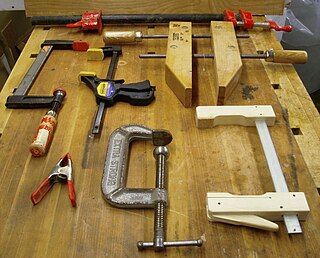
A clamp is a fastening device used to hold or secure objects tightly together to prevent movement or separation through the application of inward pressure. In the United Kingdom the term cramp is often used instead when the tool is for temporary use for positioning components during construction and woodworking; thus a G cramp or a sash clamp but a wheel clamp or a surgical clamp.
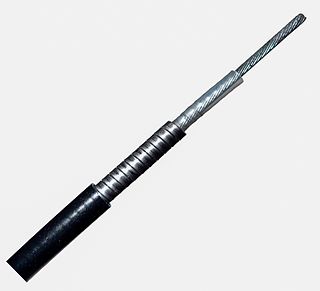
A Bowden cable is a type of flexible cable used to transmit mechanical force or energy by the movement of an inner cable relative to a hollow outer cable housing. The housing is generally of composite construction, consisting of an inner lining, a longitudinally incompressible layer such as a helical winding or a sheaf of steel wire, and a protective outer covering.

A ferrule is any of a number of types of objects, generally used for fastening, joining, sealing, or reinforcement. They are often narrow circular rings made from metal, or less commonly, plastic. Ferrules are also often referred to as eyelets or grommets within the manufacturing industry.
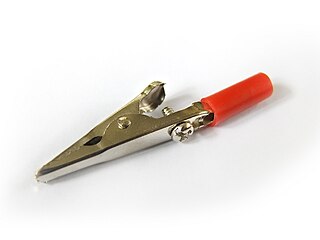
A crocodile clip or alligator clip is a plier-like spring-tensioned metal clip with elongated, serrated jaws that is used for creating a temporary electrical connection. This simple mechanical device gets its name from the resemblance of its serrated jaws to the toothed jaws of a crocodile or alligator. It is used to clamp and grab onto a bare electrical cable to an lead on a battery or some other electrical component. Functioning much like a spring-loaded clothespin, the clip's tapered, serrated jaws are forced together by a spring to grip an object. When manufactured for electronics testing and evaluation, one jaw of the clip is typically permanently crimped or soldered to a wire, or is bent to form the inner tubular contact of a ~4 mm (0.16 in) female banana jack, enabling quick non-permanent connection between a circuit under test and laboratory equipment or to another electrical circuit. The clip is typically covered by a plastic shroud or "boot" to prevent accidental short-circuits.

A fastener or fastening is a hardware device that mechanically joins or affixes two or more objects together. In general, fasteners are used to create non-permanent joints; that is, joints that can be removed or dismantled without damaging the joining components. Welding is an example of creating permanent joints. Steel fasteners are usually made of stainless steel, carbon steel, or alloy steel.
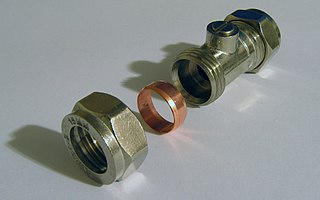
A compression fitting is a fitting used in plumbing and electrical conduit systems to join two tubes or thin-walled pipes together. In instances where two pipes made of dissimilar materials are to be joined, the fittings will be made of one or more compatible materials appropriate for the connection. Compression fittings for attaching tubing (piping) commonly have ferrules in them, and are sometimes referred to as flareless fittings. There are also flare fittings that do not require ferrules/olives.
A stuffing box or gland package is an assembly which is used to house a gland seal. It is used to prevent leakage of fluid, such as water or steam, between sliding or turning parts of machine elements.

A nipple clamp is a type of sex toy that is applied to a person's nipples to pinch them. Varieties of nipple clamp include clothes-pin-style, tweezer and clover. Nipple clamps are used to cause pain in the nipples as part of certain BDSM activities. They are also used to produce erotic stimulation as part of nipple play. In this context they are not primarily used to produce pain but rather to increase nipple sensation. Their use traps blood in the nipples, increasing the sensitivity of the nipple. The sexologist Carol Queen says that "clamps are also very useful for hands-free nipple play".

A band clamp is a generic term for a holding device usually consisting of a strap of metal or cloth formed into a loop, with a mechanism to forcibly adjust the diameter, thereby exerting a squeezing force on an object within the loop.

In plumbing and piping, a nipple is a fitting, consisting of a short piece of pipe, usually provided with a male pipe thread at each end, for connecting two other fittings.
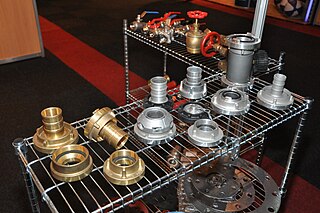
A hose coupling is a connector on the end of a hose to connect it with another hose or with a tap or a hose appliance, such as an irrigation sprinkler. It is usually made of steel, brass, stainless steel, aluminium or plastic.
Flare fittings are a type of compression fitting used with metal tubing, usually soft steel, ductile (soft) copper and aluminum, though other materials are also used. In a flare fitting the tube itself is "flared" i.e. expanded and deformed at the end. The flare is then pressed against the fitting it connects to and is secured by a close-fitting nut that ensures that no leakage happens. Tube flaring is a type of forging operation, and is usually a cold working procedure. During assembly, a flare nut is used to secure the flared tubing's tapered end to the also tapered fitting, producing a pressure-resistant, leak-tight seal. Flared connections offer a high degree of long-term reliability and for this reason are often used in mission-critical and inaccessible locations.

A pipe is a tubular section or hollow cylinder, usually but not necessarily of circular cross-section, used mainly to convey substances which can flow — liquids and gases (fluids), slurries, powders and masses of small solids. It can also be used for structural applications; hollow pipe is far stiffer per unit weight than solid members.

A fitting or adapter is used in pipe systems to connect straight sections of pipe or tube, adapt to different sizes or shapes, and for other purposes such as regulating fluid flow. These fittings are used in plumbing to manipulate the conveyance of water, gas, or liquid waste in domestic or commercial environments, within a system of pipes or tubes.

Ground glass joints are used in laboratories to quickly and easily fit leak-tight apparatus together from interchangeable commonly available parts. For example, a round bottom flask, Liebig condenser, and oil bubbler with ground glass joints may be rapidly fitted together to reflux a reaction mixture. This is a large improvement compared with older methods of custom-made glassware, which was time-consuming and expensive, or the use of less chemical resistant and heat resistant corks or rubber bungs and glass tubes as joints, which took time to prepare as well.

A screw terminal is a type of electrical connection where a wire is held by the tightening of a screw.

Breast torture is a BDSM activity in which sexual stimulation is provided through the intentional application of physical pain or constriction to the breasts, areolae or nipples of a submissive. It is a popular activity among the kink community. The recipient of such activities may wish to receive them as a result of masochism or they may have a desire to please a dominant who is sadistic. Those involved may also be motivated by breast fetishism. Mild breast torture such as light impact play on the breasts is also occasionally used outside of the BDSM context to provide stimulation and pleasure during conventional sex.
ISO 2852Stainless steel clamp pipe couplings for the food industry was an international standard that defines a non-permanent sanitary food-grade piping interconnect method, commonly used in the food processing industry and with dairy farm equipment.

A cam and groove coupling, also called a camlock fitting, is a form of hose coupling. This kind of coupling is popular because it is a simple and reliable means of connecting and disconnecting hoses quickly and without tools.

A scuba cylinder valve or pillar valve is a high pressure manually operated screw-down shut off valve fitted to the neck of a scuba cylinder to control breathing gas flow to and from the pressure vessel and to provide a connection with the scuba regulator or filling whip. Cylinder valves are usually machined from brass and finished with a protective and decorative layer of chrome plating. A metal or plastic dip tube or valve snorkel screwed into the bottom of the valve extends into the cylinder to reduce the risk of liquid or particulate contaminants in the cylinder getting into the gas passages when the cylinder is inverted, and blocking or jamming the regulator.